The history of couches, sofas, and settees goes a long way back. The word “sofa,” for example, dates back to 2000 BC in Egypt, and was derived from the Arabic term “suffah” which translates roughly to bench. This means that people have been relaxing on sofas and couches for thousands of years – and this is not changing any time soon.
Today, the earliest surviving sofas date back to the 17th century. These antique couches, sofas, and settees boast a range of iconic styles that have graced our interiors for hundreds of years now. In this detailed guide, we will help you discover 21 antique couch, sofa, and settee styles.
Table of Contents
21 Standout Couch, Sofa, and Settee Styles
1. The Chesterfield Sofa
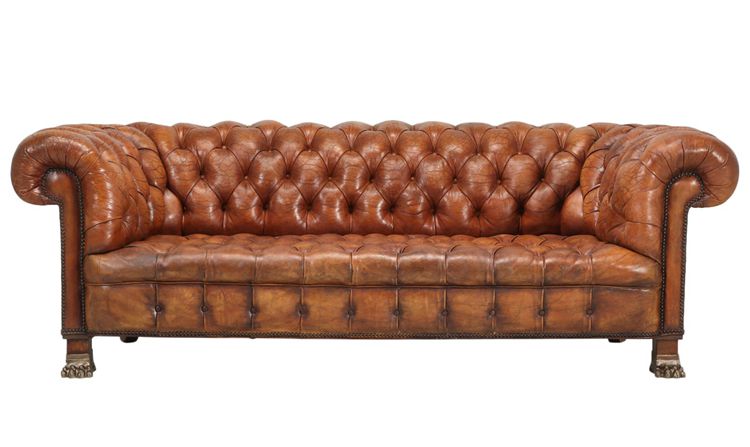
Among the most standout – and famous – sofa styles is the long-standing Chesterfield sofa. The burly and button-backed sofa has lent timeless elegance to homes – specifically the interiors – for almost 300 years.
The lore around the Chesterfield sofa is that it was invented by a court artisan in the mid 18th century. Soon after, the fourth Earl of Chesterfield, Sir Philip Stanhope, commissioned a similar sofa.
Chesterfield sofas are generally characterized by their bulky frames which feature rolled arms the same height as the sofa’s back. Typically, you will see a studded trim and a deep button tufting.
Today, chestnut leather-clad Chesterfield sofas populate traditional settings, including libraries and private clubs. However, these sofas can be a witty style statement when you upholster them in a more unusual fabric – think of a bright pop of color or jaunty tartan.
2. The Camelback Sofa
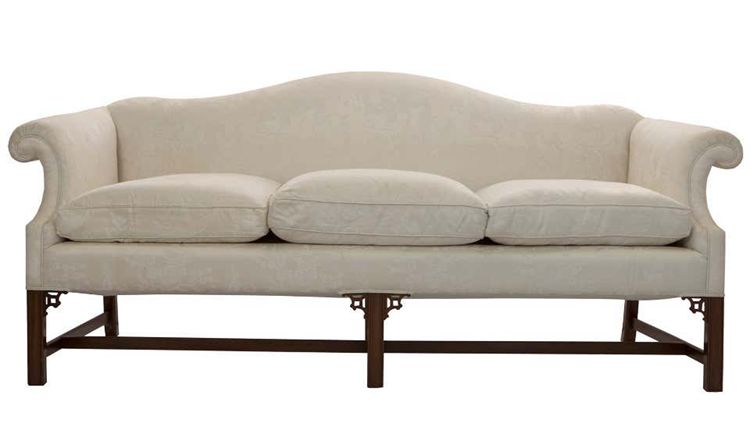
The elegant camelback sofa derives its style from the antique Georgian sofa that is still highly coveted in the 21st century. From looking at the sofa, it is easy to see where the name “camelback” comes from – the settee’s frame features a distinctive ‘bump’ in the center which creates curving linearity.
Typically, the sofa is suspended over its heightened frame whose simple angularity contrasts perfectly with its graceful, arched back. The classic and refined seat was designed by Thomas Chippendale – a famous English furniture maker – and was extremely popular from the beginning of the 18th century to the 1850s.
The sofa’s foot and leg styles do vary depending on the sofa’s manufacture period. The cabriole feet support the Chippendale and Queen Anne camelback sofas while the Hepplewhite sofa style is supported by simple tapered legs.
While someone might feel that the antique camelback sofa is extra formal for the modern interiors, this is not true. The camelback sofa style is a great candidate for sofa reupholstery. The sofa style undergoes a dramatic transformation when you pair it with a fresh print.
3. Divan Sofa
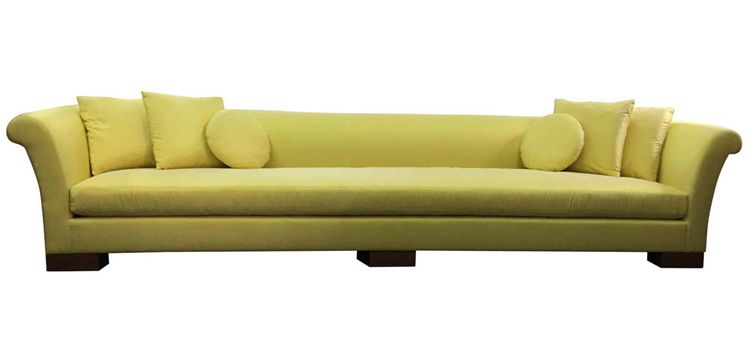
Originating from the Middle East, the divan sofa is an antique sofa style stemming from long past empires. This sofa style became popular during the reign of the Ottoman Empire. Originally, the sofa functioned as a floor mattress that would lean upon a raised structure or the side of a room.
The sofa’s name, “divan” has its origin in the Persian government terminology. The sofa would line the walls in the Middle Eastern council chambers of the bureau – the chambers were called the diwan.
Long and narrow Levantine homes also used divans although the term became well known in 1702. Between 1820 and 1850, the divan sofa style became more and more fashionable, largely because of the sofa’s elevation in literary romantic movements.
Coffee houses and boudoirs, which boasted a lot of Turkish influence, were adorned with the divan sofas. In the 21st century, a cigar divan is still a well-known expression that echoes in other languages, including Italian as divano, Romanian as divan, and Hungarian as dívány.
A recent equivalent to the divan sofa style is the daybed, a piece of furniture favored by mid-20th century furniture designers. The designers in this era used teak to make simple but sleek frames with tapered feet on which the elongated cushion would rest.
4. Antique Loveseats
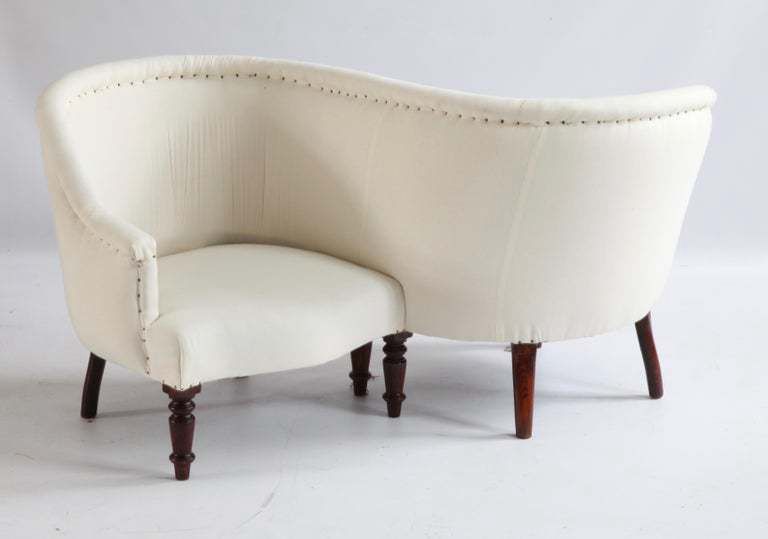
The lovely name of this sofa style would suggest that it has a romantic origin. However, this is not the case.
Little is currently known about who first came up with the idea of the loveseat. However, we know that the earliest models of the sofa styles were not created for amorous reasons.
The loveseat existed to accommodate large, poofy dresses belonging to fashionable women. These included petticoats, underskirts, layers, and hoops which were extremely popular back then. The billowing skirts needed an extra room – the loveseat offered this space.
The original loveseat was made up of 2 chairs that faced inwards so that its occupants could position themselves in a way that allowed them to have a good natter. These original loveseats go back to the 17th century. However, over the centuries, as clothes started slimming down, people took advantage of this oversized chair to sit closer to each other.
During the Victorian era, middle and upper-class homes favored the loveseat, which, in turn, converted it into a status symbol of elitism. During the Industrial Revolution, however, the compact loveseat became a staple fixture in working-class homes, especially in houses where space was at a premium.
The sofa’s space-saving capabilities have sustained its popularity in the 21st century. The designs for the sofa style have also evolved – the most recent loveseats allow occupants to sit facing forward but, suitably for the loveseat, the occupants still seat side by side.
5. Knole Sofa
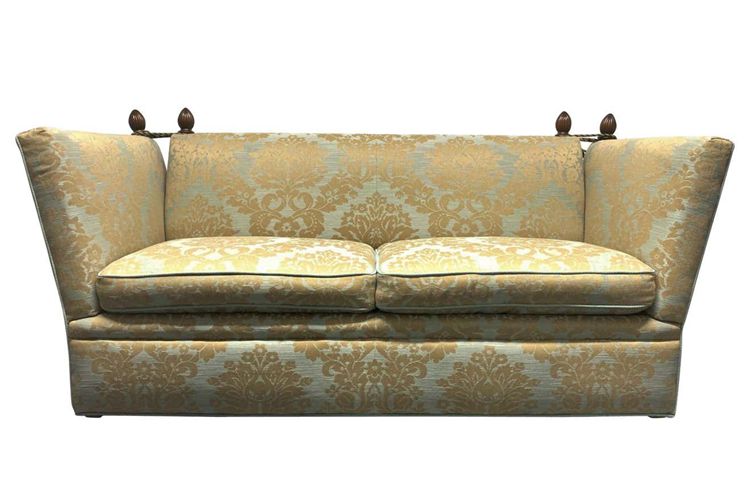
A descendant of the original 17th-century sofa – which is still available in Knole House in Kent, England – the Knole sofa is the one that gained a lot of admiration from furniture fans for its unique and aesthetically appealing look.
The Knole sofa was originally designed for the monarch as a throne-like sofa. The monarch used the Knole settee when receiving visitors. The sofa was wide enough to allow the consort and the monarch to seat side by side.
The sofa’s design features included adjusted side arms and a considerable seating depth. The settee usually featured exposed wooden finials at the rear corner tops, with some exposed wood being present on its arms. The arms – more correctly, the sofa’s sides – feature the same height.
The side arms are tied to the back of the sofa using a heavy decorative braid. The braid often features an elaborate tassel. It is worth noting that some of these elements, for example, the finials, may not be available on modern Knole sofa styles.
6. Louis XV Settee
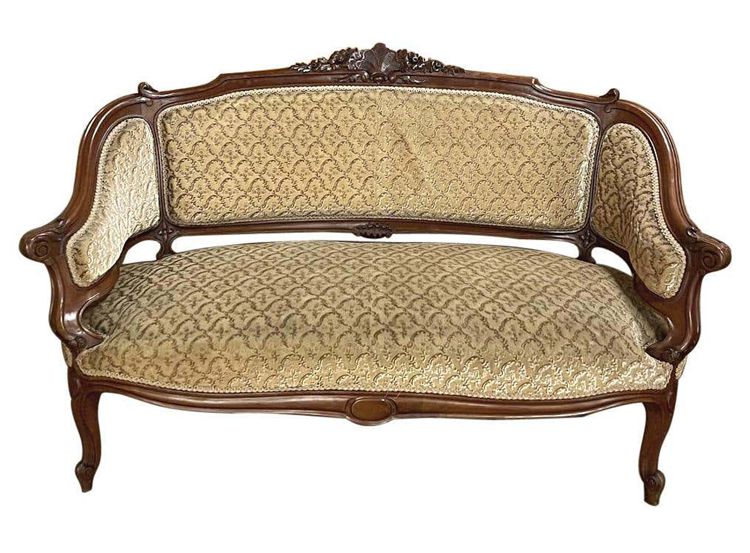
The Louis XV settee dates back to between 1715 and 1774. The sofa style replaced the more formal, massive, and box-like furniture of the Louis XIV style.
Refined and timeless, the Louis XV settee is a delicate piece of furniture that can work well in any interior. This settee style works well in classic contemporary and classical spaces.
The settee’s grandeur and elegance are thanks to its exposed wood frame (a standout feature that is visually lighter), arm pads, and intricate carvings. The sofa style employed marquetry, using exotic woods of varying colors, as well as pearl and ivory. Shell carvings and sinuous lines set the settee style apart from the earlier Louis XIV sofa designs.
The Louis XV settee style has 3 distinct periods. During the early years (that is, between 1715 and 1730), when the king was still too young to rule, the sofa style followed massive, geometric Louis XIV style. Between 1730 and 1750, the style became more ornate, exuberant, and asymmetrical. From 1750 to the king’s death in 1774, the sofa style featured decorative elements of Chinoiserie and other exotic ornaments.
When upholstered in a traditional damask or brocade, the result is one of rich opulence. However, modern velvet and neutral linen are equally chic.
In the original designs of the sofa style, nailhead trim was a common choice. Nowadays, however, piping is frequently used.
7. Louis XV Canape
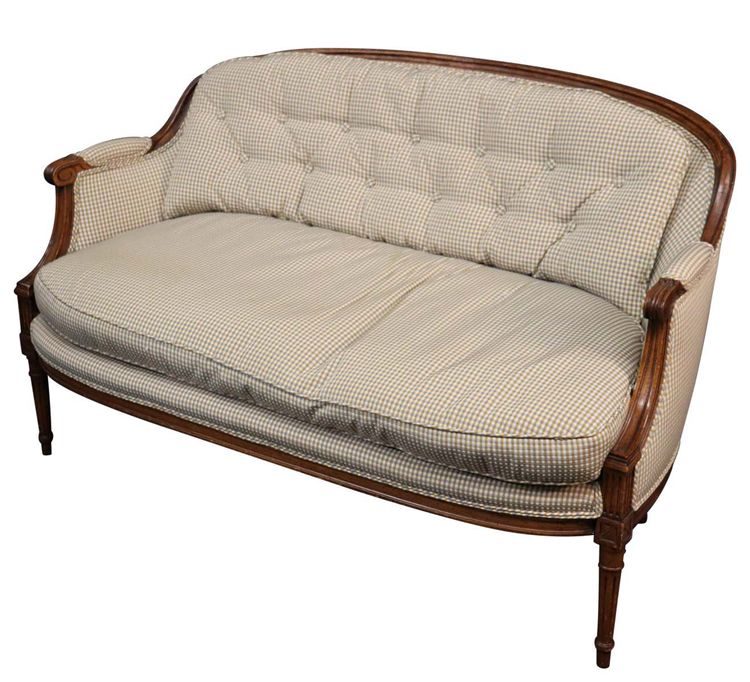
Also called the baguette-shaped canape, the Louis XV canape is defined by the grand Rococo design. Notable for its exposed wooden frame, the settee style uses an enveloping shape that curves at the ends and merges the backrest with its sloped arms in one unbroken silhouette.
The sofa’s back is upholstered on both the inside and outside. This generally creates a sense of luxury as the sofa’s rich wood contrasts perfectly with the opulent upholstery.
This couch style dates back to the 18th century. During this period, the majority of the Louis XV canapes were designed to accommodate up to 3 people.
8. English Club Sofa
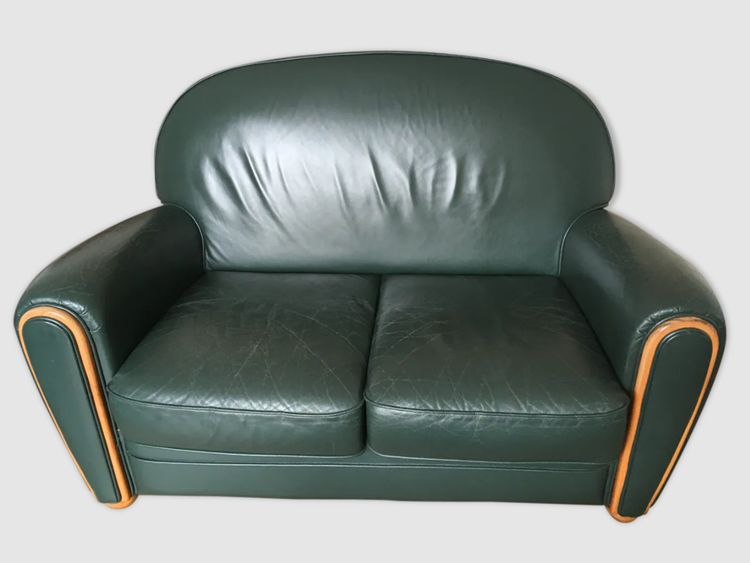
Dating back to the beginning of the 20th century, the English club sofa is a classic of the traditional British interiors. The sofa style features pleated, rolled arms that are slightly set back from the front. The sofa rests on turned wooden legs on casters and softened lines.
Casual yet sophisticated, the sofa style has 2 seat cushions and an impressive backrest that add to its heritage appeal. The sofa style is generally well-suited to country and traditional settings.
The couch style offers a quaint aesthetic appeal, especially when you enhance it with charming fabric. An attractive block color linen sits perfectly well in a coastal environment while a plush velvet gives the sofa an unexpected luxury.
9. Art Deco Sofa
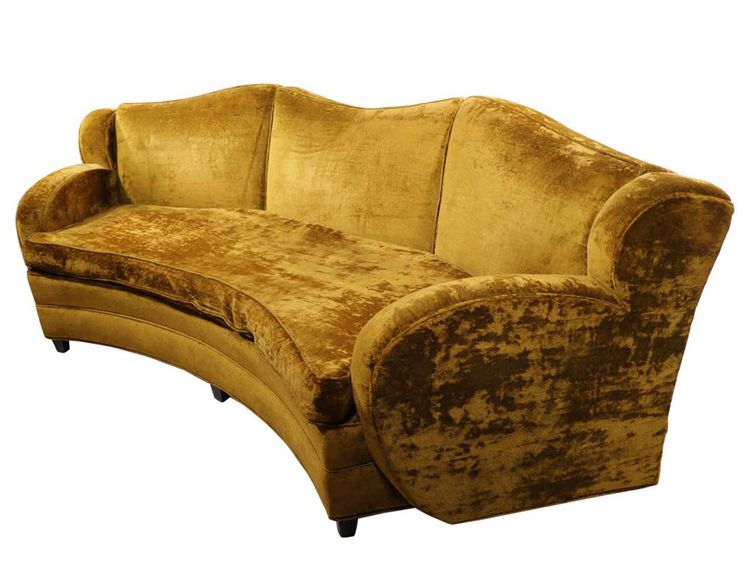
Introduced in the furniture market at the beginning of the 20th century, the art deco sofa style is a fine example of Art Deco’s use of flattened planes and curved lines.
The couch’s piped edges keep the style crisp. Its simple – often block – feet are vital of the movement’s divergence from streamlining motifs to the ornamental couch.
This is a statement sofa that performs well when used in a formal space. It may not work well in a space designed for lounging.
Due to its curved ends, the sofa may require a bigger footprint. This should be borne in mind when planning a furniture arrangement that involves the art deco couch style.
10. Midcentury Modern Sofa
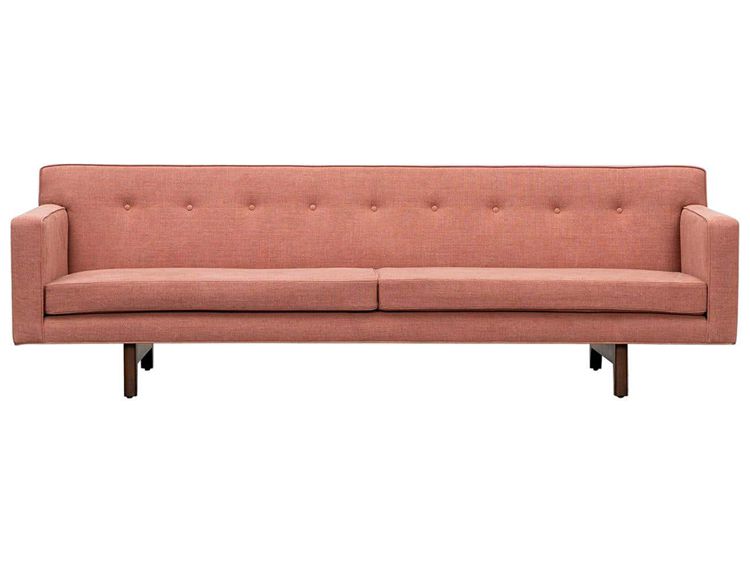
Originally designed by Edward Wormley in the mid-20th century, this couch style has become a personal favorite for most people in recent years. The Midcentury Modern sofa – just like its antecedent, the game-changing Modernist movement – came to replace the traditional ornamentation for streamlined shapes.
Loved by interior designers for its playful but forward-thinking style. Midcentury sofas are recognized by their shallow button tufting (which is generally a precise, single row), simple frame, and blocky silhouette. The addition of its bolster end cushions gives the sofa an identifiable retro aesthetic.
11. Lawson Sofa
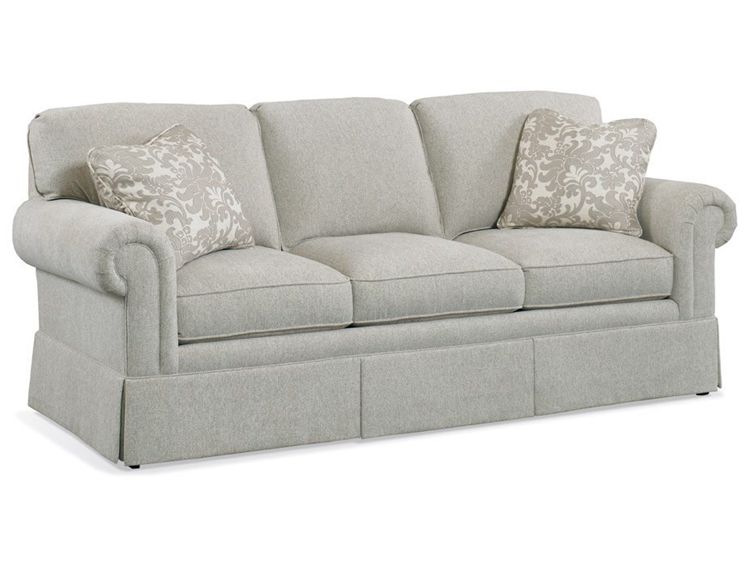
Created for financier Thomas Lawson near the 20th-century turn, the Lawson sofa style has clean lines that reflect his desire for simpler, more modern, and more comfortable construction than the ornate Victorian styles that were available back then.
Fitted, scroll arms, masses of space, and plush cushions make the Lawson sofa a comfortable addition to any room. The couch’s generous proportions make it ideal for lounging, with its smart but casual appearance making it preferable to many homeowners.
The straight legs option lends the Lawson sofa an extra modern appearance while its tailored skirt leans it toward the traditional décor. A “track” or rectangular arm makes it a perfect choice for an urban loft while the sock arm makes it ideal for a cottage-style or more traditional home.
The couch style allows homes to add several throw pillows that suit their look. Triangle-shaped accent pillows complement the modern sitting space while the square ones trimmed with a cord or fringe fit a traditional relaxing zone.
12. Tuxedo Sofa
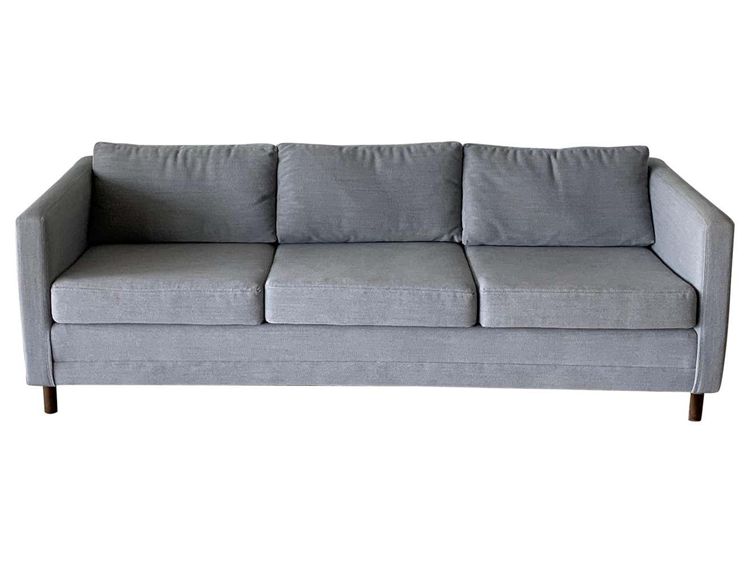
Dating back to the 1920s, the tuxedo couch typically features a boxy and streamlined shape, which is why most people call them square sofas. The arms of the tuxedo sofa are generally an extension to the couch’s backrest, creating an impressively uniform upper build.
Precise upholstery and proportions give the couch style a refined appeal and turn it into a sophisticated silhouette, the equivalent of a tailored suit in the furniture world. The couch style features a special – though not necessary – nailhead trim that reinforces its sharp lines.
Characterized by clean lines, the couch style is one of the slickest you could choose. Instead of drawing attention because of its elaborate features, the couch uses its strong visual aesthetic appeal to attract attention from guests.
The sofa’s inherently structured form encourages its users to sit upright. This makes it ideal for a formal furniture arrangement.
13. Sectional Sofa
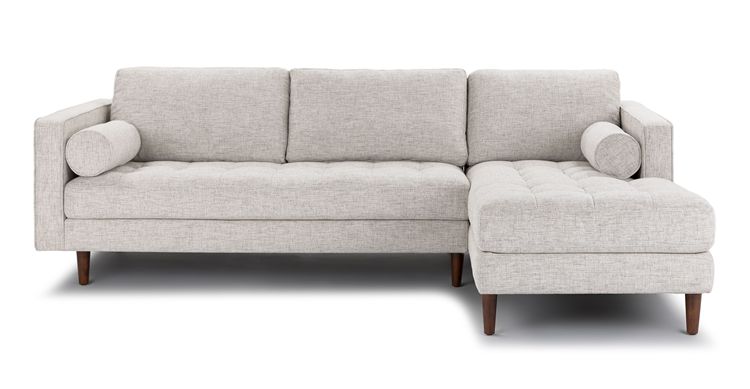
A mainstay of the modern interiors, the sectional sofa was originally designed to be multi-functional. The designer’s main goal was to ensure the sofa could offer both comfort and flexibility.
Thanks to the couch’s numerous configurations and interdependent, individual components, the couch style can be customized to suit almost any space. Featuring at least 2 sections, the sectional sofa’s elements can be placed together allowing it to elongate. The couch wraps around a corner, with a 90-degree join.
The couch style allows the inclusion of chaise longs and close-end pieces to make the design self-contained. One of the couch’s main defining features is a barely-there structure – this usually refers to its slender metal legs.
According to historians, the sectional sofa style was invented at the turn of the 19th century. The couch’s origin can be traced to the United States, in an area in Virginia near Washington D.C.
14. Boudeuse Sofa
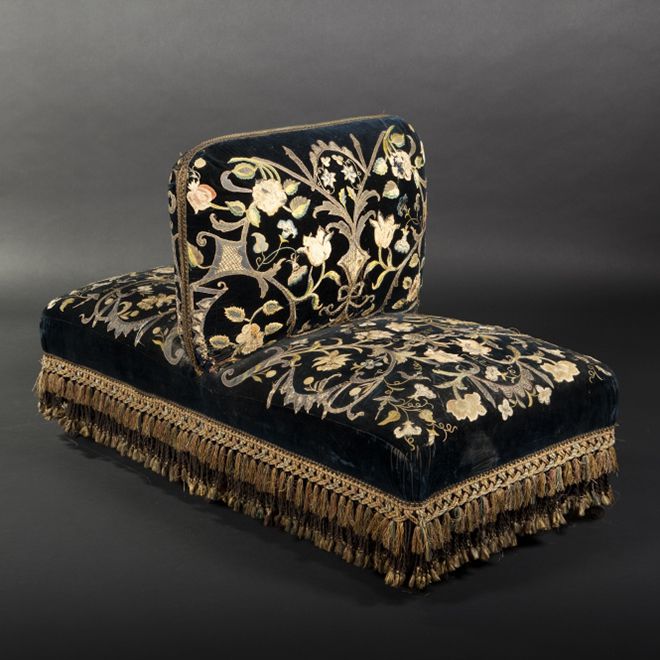
A loveseat of sorts, the Boudeuse couch is a small upholstered sofa featuring 2 seats that share a common backrest so that the sitters can face in the opposite directions. The couch’s origin can be traced back to the mid-19th century in France. In French, the sofa style is called the dos-a-dos (which means back-to-back).
The sofa style is characteristic of the luxurious and ornate Second Empire furniture. The couch usually employs a coil-spring technology in its seat.
Boudeuse is a French term for “sulky.” The term is typical, perhaps, of the mood that a pair of lovers who sat facing away from each other on this couch would have.
15. Canapé à Confidante Sofa
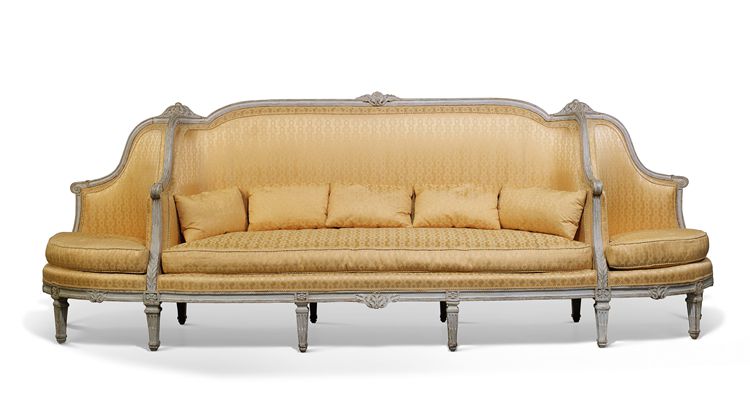
The Canapé à Confidante is a long couch that features a seat at each end that faces outward at right angles to the main section of the couch. This couch style was developed in France and dates back to the 18th century. The couch style is a good reflection of the new types of furniture that were emerging at the time.
The Canapé à Confidante is characteristic of the rococo and Louis XV styles, as well as other mid 19th century revivals of the sofa styles. The Canapé à Confidante was intended for seating 3 people, except that its center section is generally much longer than the 2 side seats.
16. Chair-Back Settee
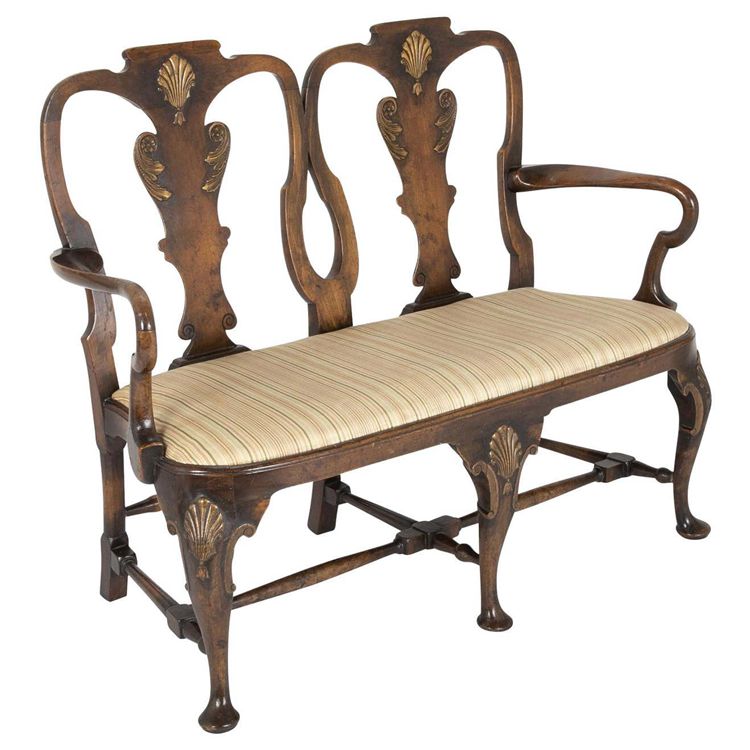
This is a couch style in which the backrest is made up of 2, 3, or more distinct chair frames. The settee style creates an effect of a series of chairs that share a common seating area.
One of the earliest couch styles, the chair-back settee first came into play in the late 17th century. It maintained its popularity well into the 19th century with the legs, feet, and backs reflecting the predominant styles of each period.
It is worth noting that the chair-back settee style is making a modern comeback. A lot of do-it-yourself fans are combining individual chairs that feature interesting backs to create the chair-back settee.
17. Davenport Sofa
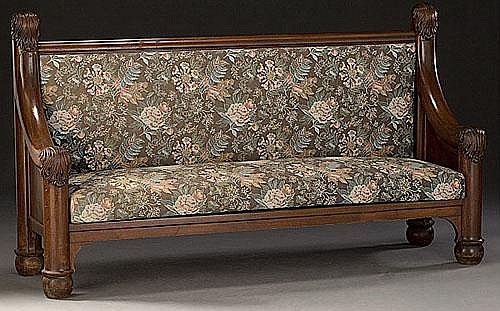
In the United States, the term “Davenport Sofa” referred to a squarish sofa featuring high arms and back, and usually upholstered. The couch’s style can be traced to the turn of the 20th century.
The style’s name originated from the Davenport Company of Boston – which later became the Irving & Casson & Davenport – which was known for producing furniture designed by an architect known as H.H. Richardson.
The term “Davenport” became somewhat generic and was applied to almost any couch and sofa in upstate New York and the Midwest. The name was popular enough that when the first sofa beds were invented, they were given the name “Davenport beds.”
Today, Davenport also refers to a small, portable English desk. In modern terms, the term is largely used for the desk style.
18. Indiscret Sofa
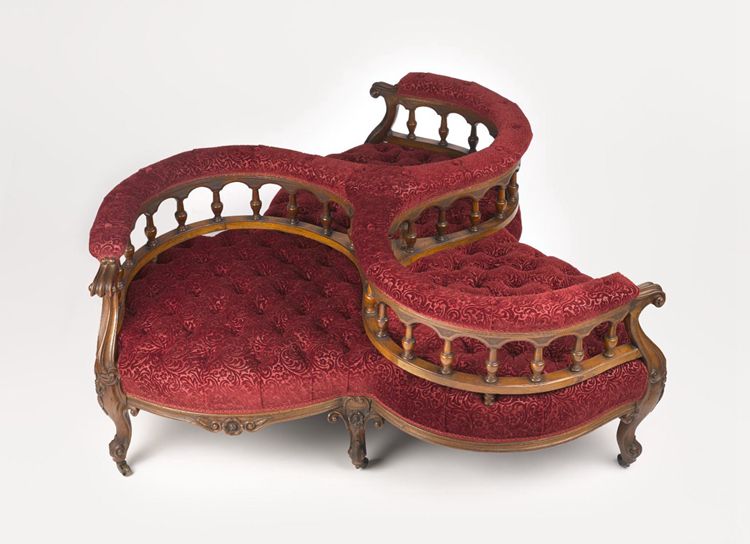
This is an upholstered sofa that can seat a maximum of 3 people. Developed in the mid-19th century in France, the settee style takes two forms.
The earlier version which dates back to the 1830s was a circular couch, divided into 3 sections that shared a single tall back in the center. The second form, which emerged during the Second Empire, featured 3 connected armchairs that are arranged in a pinwheel pattern – this is the form that appears in the picture. Both forms are ornately carved and feature a tufted upholstery that uses coil spring technology.
The couch style is sometimes called the conversational couch. It is not uncommon for some people to erroneously identify it as the tête-a-tête which only seats 2 people.
19. Méridienne Daybed
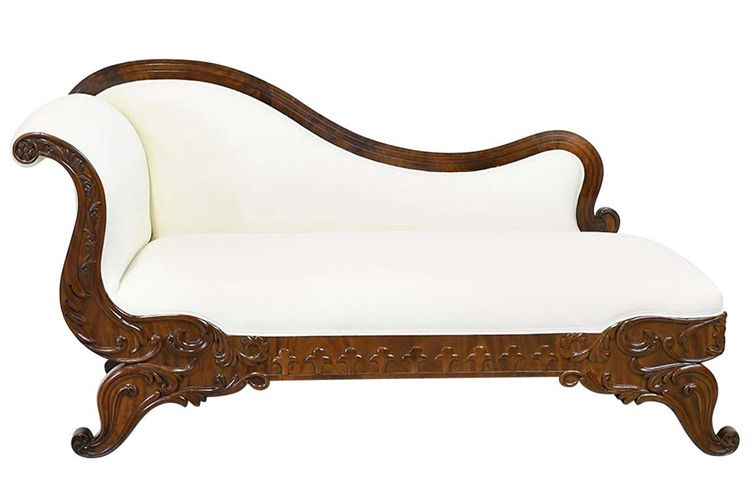
Also known as the fainting couch, Méridienne Daybed is a cross between a chaise lounge and a sofa. The Méridienne Daybed is characterized by a sloping back running along the length of the piece and connecting its high headrest and footrest. The couch’s legs can vary in shape, but the footrest (when present) and headrest are typically rolled and curved.
Designed and developed in the early 1800s, the Méridienne Daybed is associated with the late French Empire and the English Regency, though the couch’s popularity continued through the 19th century and beyond.
20. Récamier Daybed
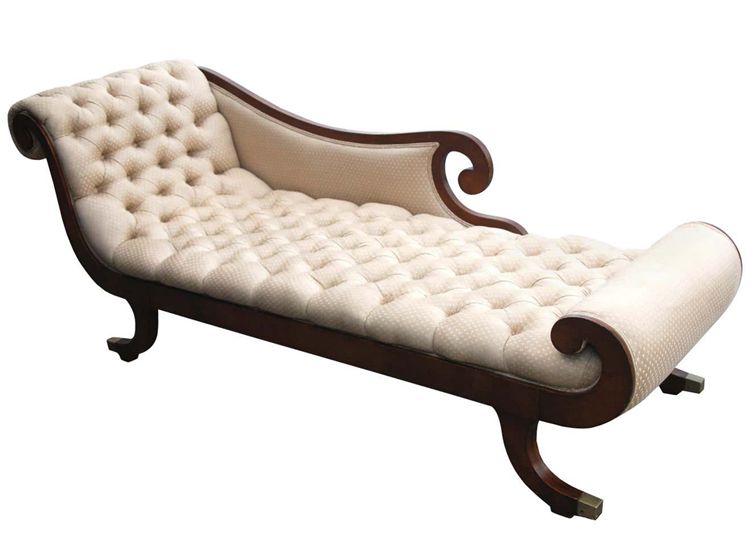
The Récamier Daybed is a light daybed that generally doubles as a sofa. It features a scrolled but shorter footboard and a correspondingly curved headboard. Originally backless, later versions of this settee style featured a low backrest, sometimes sloppy, that ran either partly or fully down the length of the Récamier Daybed.
Developed in the late 18th century in France, the daybed was named after Madame Récamier, a Parisian style-setter, and hostess who was pictured reclining on one of the daybeds in a framed portrait. The couch style is characteristic of the English Regency, American Federal, and French Directoire/Empire styles.
21. Windsor Settee
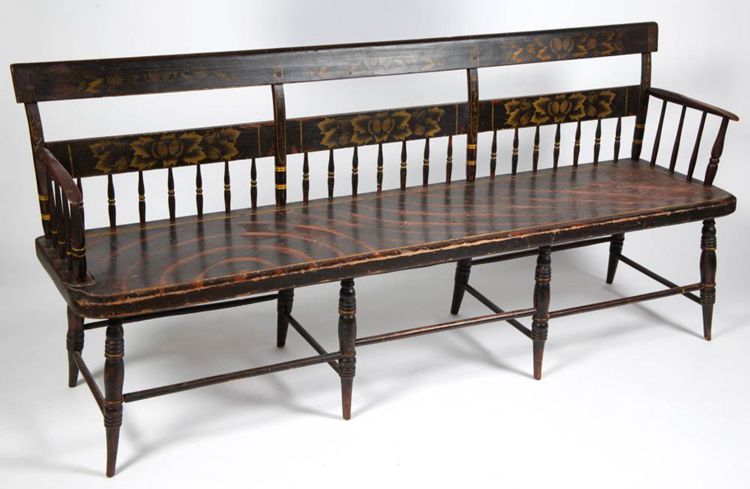
A variation of the Windsor chair, the Windsor settee has a long bench, with sides and a back that features multiple spindles inserted in holes on the base of a sunken and often saddled seat. Typically, the settee style has 6 legs that are inserted in holes in the seat. The legs are often connected with H-stretchers and sprayed.
The legs can be curved and turned to simulate bamboo or tapered to end in an arrow or simple foot. The settee’s arms might be paddle-, S-, L-, or knuckle-shaped.
The settee’s spindled backs generally come in various shapes, similar to those on a common chair (bow-back, sack-back, etc.). Straight low-backs were common in the early days. Another variation was the arrow-back, which referred to the spindles themselves, which were often flattened and tapered at the end to suggest arrows.
The Windsor settees were often produced using different wood types. For this reason, they were usually painted. This Windsor settee style seems to have originated in America, produced for the first time in the 1750s, most probably in Philadelphia.
Conclusion
In an age of modern couch manufacturers on almost every high street, antique sofas and settees might seem like a funny prospect to some people. However, as the design pendulum inevitably swings, antique couch, sofa, and settee styles are asserting new relevance in interior design. The nostalgic embrace of their traditional design has long colored aesthetic tastes worldwide.
In this detailed guide, we have discussed 21 antique couch, sofa, and settee styles. Taking a deeper look at the appearance and features of each antique couch style, this guide should help homeowners interested in vintage sofas choose something that suits their needs.
If you have any questions about the antique couch, sofa, and settee styles, talk to us in the comments section. One of our experienced interior designers will respond to your question with a detailed answer.






![Vintage Schwinn Bikes: [Types, Identification, and Values]](https://www.txantiquemall.com/wp-content/uploads/2022/05/5.-Schwinn-1967-Ramshorn-Fastback-Stingray-Sky-Blue-vtg-600x450.jpg)
